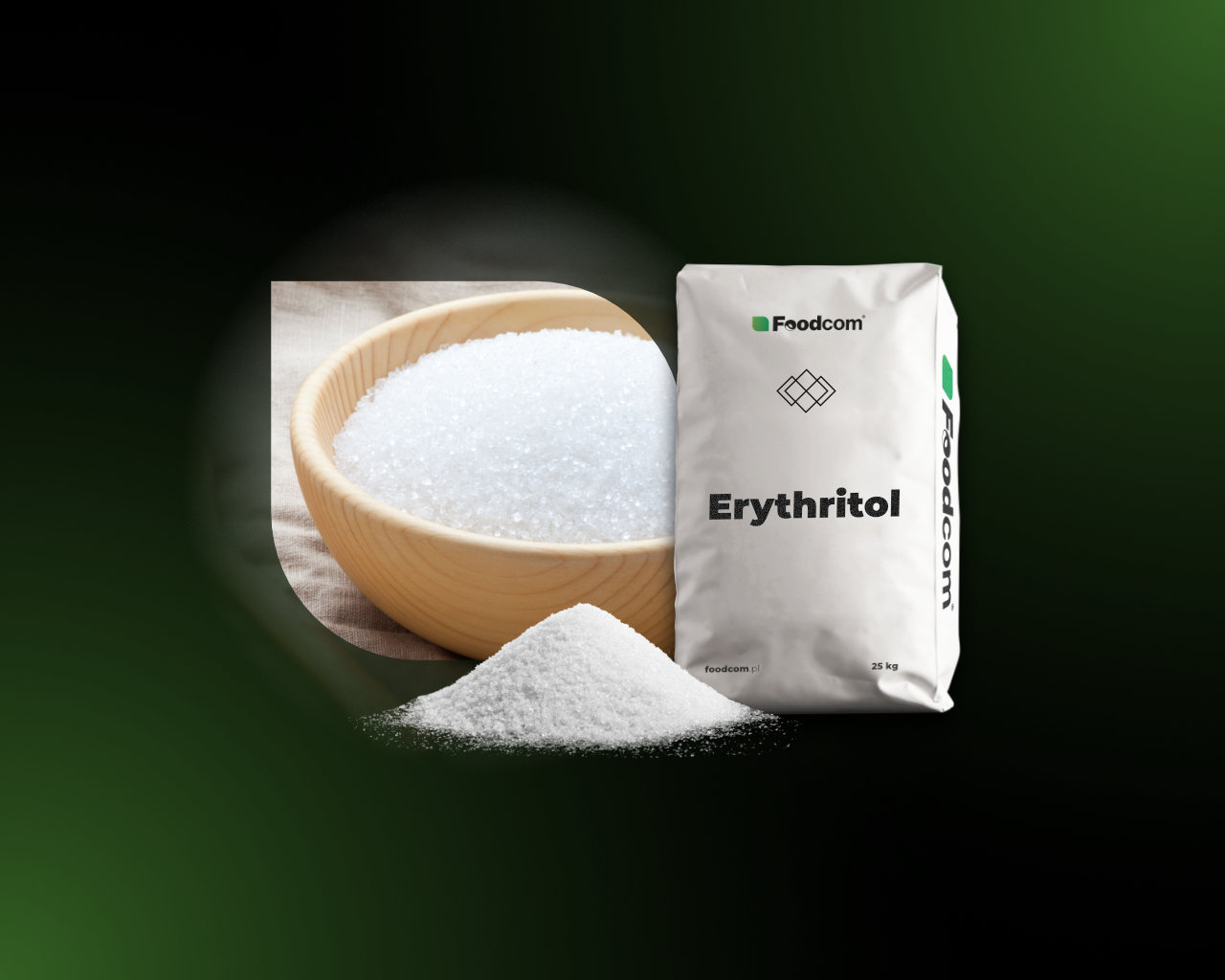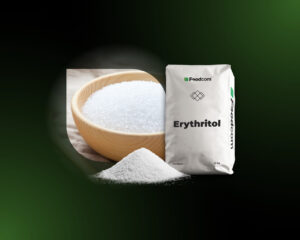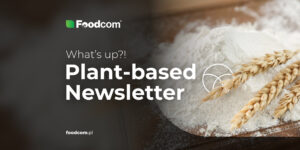- Erytrytol to poliol występujący naturalnie w niektórych owocach i produktach fermentowanych.
- Ze względu na swój słodki smak jest stosowany jako substytut cukru.
- Jest to substancja bezpieczna dla diabetyków i nie przyczynia się do rozwoju próchnicy.
- Erytrytol jest wykorzystywany w przemyśle spożywczym, farmaceutycznym i kosmetycznym.
Co to jest Erytrytol?
Erytrytol jest rodzajem węglowodanu znanym jako poliol, inaczej określanym jako cukier alkoholowy. Nie zawiera on jednak ani alkoholu, ani cukru, ale posiada właściwości chemiczne obu tych substancji. Erytrytol naturalnie występuje w niektórych owocach i produktach fermentowanych, ale może być również produkowany przemysłowo.
Erytrytol jest uważany za bezpieczny dla diabetyków, ponieważ nie zwiększa poziomu cukru we krwi. Większość Erytrytolu spożywanego przez organizm nie jest trawiona i dlatego nie powoduje problemów trawiennych, w przeciwieństwie do innych polioli. Erytrytol nie przyczynia się również do próchnicy, co oznacza, że nie wpływa na zęby. Ponadto produkt jest bezglutenowy i odpowiedni dla diet wegańskich, wegetariańskich, paleo i keto.
Erytrytol jest również znany pod nazwą erytrol. Jako dodatek do żywności ma symbol E968.
Z czego produkowany jest Erytrytol?
Erytrytol można znaleźć w małych ilościach w różnych naturalnych źródłach, zwłaszcza w owocach i produktach fermentowanych. Znajduje się on m.in. w gruszkach, winogronach, arbuzach, grzybach, winie lub piwie. Przemysłowo produkowany Erytrytol otrzymuje się poprzez fermentację glukozy lub fruktozy z wykorzystaniem drożdży i innych mikroorganizmów. Surowcem do produkcji Erytrytolu jest zazwyczaj kukurydza lub sfermentowane owoce nienadające się do bezpośredniego spożycia przez ludzi.
Erytrytol – właściwości
Erytrytol występuje w postaci białego, krystalicznego proszku lub granulek, bez obcych zapachów. Jest 60-70% mniej słodki niż Sacharoza i ma charakterystyczny, świeży smak w ustach z lekką kwasowością. Spożywany bezpośrednio wywołuje efekt chłodzenia w ustach. Jest powszechnie mieszany z innymi substancjami słodzącymi o wysokiej intensywności, aby osiągnąć pożądany poziom słodkości. Erytrytol jest mniej rozpuszczalny w wodzie i mniej lepki niż Sacharoza i inne cukry. Charakteryzuje się dobrą stabilnością w wysokich temperaturach i środowisku kwaśnym. Posiada również bardzo niski wskaźnik higroskopijności.
Erytrytol można przechowywać przez 36 miesięcy. Aby zapewnić odpowiednie warunki przechowywania, worki z Erytrytolem powinny być umieszczone w miejscu pozbawionym światła słonecznego i wolnym od zapachów. Aby zmniejszyć ryzyko zbrylenia lub degradacji, zaleca się przechowywanie Erytrytolu w miejscu o niskiej wilgotności.
Erytrytol a Ksylitol
Erytrytol i Ksylitol to dwa rodzaje cukrów alkoholowych, które są stosowane jako substytuty cukru w przemyśle spożywczym. Chociaż oba są bezpieczne do spożycia i mają niską wartość kaloryczną, różnią się między sobą.
Erytrytol ma nieco niższą wartość energetyczną niż Ksylitol i jest łatwiejszy do trawienia przez organizm. Ksylitol z kolei ma słodszy smak. Jednak jeśli chodzi o zastosowania obu słodzików, są one bardzo podobne.
Erytrytol – zastosowanie
Erytrytol jest głównie stosowany w przemyśle spożywczym. Nie służy tylko do nadania słodkiego smaku, ale może być wykorzystywany jako wzmacniacz aromatu, środek zapobiegający zmianom smaku, konsystencji i barwy produktu, oraz do zagęszczania produktów.
Ponadto Erytrytol znajduje zastosowanie w sektorze farmaceutycznym ze względu na swoje właściwości antyoksydacyjne, niepalne i zatrzymujące wilgoć. Jest stosowany jako składnik pomocniczy w tabletkach, cukierkach do ssania lub jako nośnik substancji czynnych w produktach w formie proszku i saszetek.
W przemyśle kosmetycznym jest składnikiem różnych produktów do pielęgnacji ciała, takich jak kremy i serum przeciwstarzeniowe, ze względu na swoje właściwości minimalizujące powstawanie zmarszczek. Erytrytol, który nie wywołuje próchnicy i ma właściwości nawilżające oraz łagodzącą słodycz, jest stosowany w produkcji artykułów higieny osobistej, takich jak pasta do zębów, płyn do płukania ust, kremy i dezodoranty. Może być też wykorzystywany jako humektant.
Erytrytol w przemyśle spożywczym
Erytrytol ma bardzo niską wartość kaloryczną – znacznie niższą niż inne cukry, dlatego jest powszechnie stosowany w wyrobach o obniżonej kaloryczności i bezcukrowych. Wraz z innymi substancjami słodzącymi Erytrytol jest dodawany do wielu produktów w celu zwiększenia ich słodkości i zrównoważenia smaku poprzez dostarczenie ograniczonej ilości kalorii. Dodaje się go do artykułów spożywczych takich jak jogurty, batony czekoladowe, cukierki i galaretki. Jest częstym składnikiem bezcukrowych napojów bezalkoholowych i napojów – zwiększa ich słodycz, ale też maskuje gorycz innych składników.
Erytrytol jest również stosowany w przemyśle spożywczym jako środek spęczniający i zagęszczający, aby nadać produktowi objętość. Jest również stosowany w celu ograniczenia adsorpcji wilgoci w batonach owocowych, mieszankach mącznych i powłokach. Działa jako środek zmiękczający w gumach do żucia i twardych cukierkach. Ponieważ Erytrytol jest odporny na działanie wysokiej temperatury, może być wykorzystywany jako dodatek w wypiekach i wyrobach cukierniczych. Nie tylko nadaje im słodki smak, ale też poprawia miękkość struktury.
Dlaczego Foodcom?
Nasz zespół Wsparcia Sprzedaży pomaga naszym Partnerom Handlowym w sprawnym i efektywnym przeprowadzeniu transakcji handlowych, aby zapewnić najwyższą jakość usług dla wszystkich naszych Partnerów Handlowych. Nasz zespół logistyczny zadba o transport, a dział finansowy będzie odpowiedzialny za wszystkie sprawy związane z finansową częścią transakcji.







